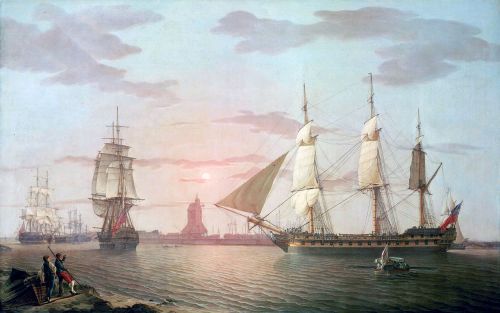The Battle of Pulo Aura off Malacca during the Napoleonic Wars.
The Warley, launched in 1796, was a 1475-ton East Indiaman and one of the East India Company’s larger and more famous vessels. She made nine voyages to the East between 1796 and 1816, most direct to China. In 1804 she participated in the Battle of Pulo Aura. In 1816, the company sold her for breaking up.
On 28 December 1803, carrying provisions for six months cruising, French Admiral Linois‘s squadron left Batavia. Sailing northwards into the South China Sea, Linois sought to intercept the HEIC China Fleet, a large convoy of East Indiamen carrying trade goods worth £8 million (the equivalent of £635,000,000 as of 2016) from Canton to Britain. The annual convoy sailed through the South China Sea and the Straits of Malacca, gathering ships from other destinations en route and usually under the protection of an escort formed from Royal Navy ships of the line. However, the 1804 fleet had no escort: the outbreak of war had delayed the despatch of the vessels from Rainier’s squadron. Thus as the convoy approached the Straits of Malacca it consisted of 16 East Indiamen, 11 country ships and two other vessels guarded by only one small HEIC armed brig, Ganges. On 14 February, close to the island of Pulo Aura, the commodore of the convoy, Nathaniel Dance, was notified that sails were sighted approaching from the south-west. Suspicious, Dance sent a number of the East Indiamen to investigate, and rapidly discovered that the strange ships were the French squadron under Linois. Dance knew that his convoy would be unable to resist the French in combat and instead decided to bluff the French by pretending that a number of his large East Indiamen were disguised ships of the line.
Dance formed his ships into a line of battle and ordered three or four of them to raise blue ensigns and the others red, giving the impression of a heavy escort by implying that the ships with blue ensigns were warships. This ruse provoked a cautious response from Linois, who ordered his squadron to shadow the convoy without closing with them. During the night, Dance held position and Linois remained at a distance, unsure of the strength of the British convoy. At 09:00, Dance reformed his force into sailing formation to put distance between the two forces and Linois took the opportunity to attack, threatening to cut off the rearmost British ships. Dance tacked and his lead vessels came to the support of the rear, engaging Marengo at long range. Unnerved by the sudden British manoeuvere, Linois turned and retreated, convinced that the convoy was defended by an overwhelming force. Continuing the illusion that he was supported by warships, Dance ordered his ships to pursue Linois over the next two hours, eventually reforming and reaching the Straits of Malacca safely. There they were met several days later by two ships of the line sent from India.
The engagement was an embarrassment for Linois, who insisted that the convoy was defended by up to eight ships of the line and maintained that his actions had saved his squadron from certain destruction. His version of events was widely ridiculed by both his own officers and the authorities in Britain and France, who criticised his timidity and his failure to press the attack when such a valuable prize was within his reach. Dance by contrast was lauded for his defence and rewarded with a knighthood and large financial gifts, including £50,000 divided among the officers and men of the convoy. The engagement prompted a furious Napoleon to write to the Minister of Marine Denis Decrès:
All the enterprises at sea which have been undertaken since I became the head of the Government have missed fire because my admirals see double and have discovered, I know not how or where, that war can be made without running risks . . . Tell Linois that he has shown want of courage of mind, that kind of courage which I consider the highest quality in a leader.
— Emperor Napoleon I, quoted in translation in William Laird Clowes’ The Royal Navy: A History from the Earliest Times to 1900, Volume 5, 1900,
